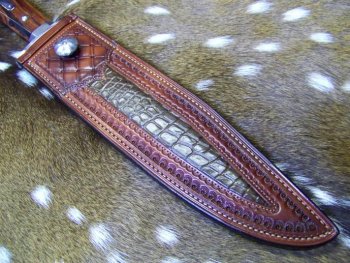Most of this I will cover when I do my tutorial, so you'll have to read it twice.For starters, I do all my marking on the flesh side of the leather and if you do any marking on the grain side use a red pen and press lightly, the darker dyes will cover it right up.I first design the "windows" on a piece of manila folder.I then cut out the template using a single edge razor blade and #11 blade in an X-acto.Using the red pen I transfer the "window" to the flesh side, and cut out window using the razor blade.I do not cut all the way to the corners.When all sides have been cut, I carefully use the #11 blade to cut to the corners.This is all done dry.After cutting trim up any spots you may have missed and if necessary use a little sandpaper or file to clean it up.I then dampen the inside edge and burnish with various sizes of antler tips(a bone folder, small round wood paint brush handles,etc. will work also)till the edge is smooth and hard.At this point I dye just the inside edge( this keeps the chances of getting dye on your inlay to a minimum).I also at this time use dividers to mark my stitch lines using the inside edge.Hope this helps and if you need anything just let me know.Dave2thumbs






